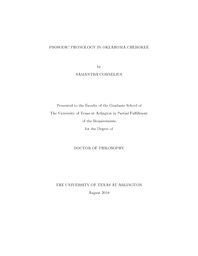
ATTENTION: The works hosted here are being migrated to a new repository that will consolidate resources, improve discoverability, and better show UTA's research impact on the global community. We will update authors as the migration progresses. Please see MavMatrix for more information.
Show simple item record
| dc.contributor.advisor | Sabbagh, Joseph | |
| dc.creator | Cornelius, Samantha | |
| dc.date.accessioned | 2018-10-24T13:53:03Z | |
| dc.date.available | 2018-10-24T13:53:03Z | |
| dc.date.created | 2018-08 | |
| dc.date.issued | 2018-09-10 | |
| dc.date.submitted | August 2018 | |
| dc.identifier.uri | http://hdl.handle.net/10106/27552 | |
| dc.description.abstract | In this dissertation, I provide an analysis for word level prosody in Cherokee, a Southern Iroquoian language spoken in Northeastern Oklahoma and Western North Carolina. Focusing on Cherokee as it is spoken in Oklahoma, I analyze right edges of Cherokee words, showing that the boundary tone is predictable, though its distribution is conditioned by lexical tonal phonology and other word-final phenomena.
In order to account for the distribution of the boundary tone, I must first provide an analysis of lexical tone in Cherokee. There have been previous comprehensive tone analyses (Lindsey 1985; Wright 1996; Uchihara 2013), which argue for a tonal inventory with two underlying tones (high and lowfall), a superhigh accent, and a default low which does not interact with the tonal phonology. I summarize these previous analyses and discuss what generalizations they can and cannot account for. I also argue that some low pitches in Cherokee are the surface realization of an underlying low tone. By including an underlying low tone in the tonal inventory of Cherokee, problematic surface pitch sequences from previous research can be explained.
Before analyzing the boundary tone, I show all possible syllable shapes and discuss Word-Final Vowel Deletion, an optional fast speech process which often results in non-canonical word-final codas. I argue that there is a prosodic word which maps to a morphosyntactic word, as well as a larger prosodic word which includes enclitics. I also describe clitic linearization and attachment, and discuss how Cherokee clitics show a number of typologically unusual properties.
Finally, I describe all possible alignments of the boundary tone. While mentions of the boundary tone in previous literature claim that the boundary tone only appears on word- final vowels, I show a much wider range of possible surface positions for the boundary tone: 1) the boundary tone appears on word-final vowel, 2) the boundary tone appears on a non word-final vowel, and 3) the boundary tone does not appear at all. I use a Stratal OT framework to account for the alignment of the boundary tone, as well as interactions between the surface position of the boundary tone and lexical tonal phonology, clitic attachment, and Word-Final Vowel Deletion. | |
| dc.format.mimetype | application/pdf | |
| dc.subject | Linguistics | |
| dc.subject | Cherokee | |
| dc.subject | Phonology | |
| dc.subject | Prosody | |
| dc.title | Prosodic Phonology in Oklahoma Cherokee | |
| dc.type | Thesis | |
| dc.degree.department | Linguistics | |
| dc.degree.name | Doctor of Philosophy in Linguistics | |
| dc.date.updated | 2018-10-24T13:53:03Z | |
| thesis.degree.department | Linguistics | |
| thesis.degree.grantor | The University of Texas at Arlington | |
| thesis.degree.level | Doctoral | |
| thesis.degree.name | Doctor of Philosophy in Linguistics | |
| dc.type.material | text | |
| dc.creator.orcid | 0000-0001-9004-6202 | |
Files in this item
- Name:
- CORNELIUS-DISSERTATION-2018.pdf
- Size:
- 5.927Mb
- Format:
- PDF
This item appears in the following Collection(s)
Show simple item record


